 Written by Hulet Smith, OT
Written by Hulet Smith, OT
Embark on a journey through the top 5 pediatric posterior walkers, each designed to empower children with mobility impairments. Discover how these innovative devices foster independence and interaction, all while providing essential support from behind. Let our team of experts guide you through the selection process, drawing from their wealth of knowledge and real-world insights to ensure you find the ideal solution for your child.
.jpg&newwidth=365) | 1) Drive Nimbo Posterior Pediatric Walker and Gait Trainer View Product |
Although we cover a lot of these features more comprehensively in our educational article on How to Choose The Best Pediatric Walker, here are some of the most important to help you determine the best pediatric posterior walker for your child.
Choosing the correct size is one of the most important determinants of how effective this walking support will be for your child. Measure the distance from the crease of the wrist to the floor, as this will show you the height range of the handgrips or armrests you need to select. Posterior walkers that offer grow-with-your-child adjustability in height and width must be adjusted to ensure the elbow is slightly bent at a 20-degree angle.
Most families opt for taking the walker wherever their child may roam, so portability is important. Lightweight, foldable walkers that are easy to fold up into a compact size to stow away in a trunk are always preferable to models that don’t. They’re also simpler to place in a closet or under a bed when not used for space-saving storage.
Several walker styles come with an integrated seat that can flip open, providing the user with a convenient place for resting when they tire of walking. When they’re not in use, they flip back up and out of the way when the user is walking.
Swiveling wheels can be great for kids with more ability and control, but they can be a nightmare for children unable to maneuver them. Swivel lock rotation facilitates easier control for children with more physical involvement. This can be unlocked as users gain additional skills and strength with gait training.
Anti-rollback wheels, also referred to as forward-rolling wheels, are an especially important feature on posterior walkers. They make it impossible for the walker to roll backward, increasing the level of safety for these walkers who provide their support from behind. No matter how hard the user leans back against the rear of the walker, it will not roll backward.
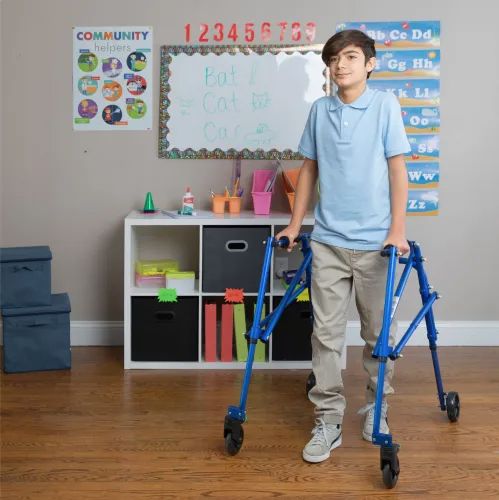
A posterior walker is usually configured as a 3-sided frame, with the back of the frame placed behind the person using it and its two sides on each side of the user. Its open front ensures the user pulls the walker by grasping the sides, doubling as balance and walking support.
Kids with temporary or permanent mobility impairments use posterior walkers for balance and walking support. Pediatric posterior walkers may be indicated for children following illness, injury, or surgery, helping some youngsters regain walking skills, proper gait patterns, and leg strength. They’re also commonly used by children with cerebral palsy and other congenital disorders, developmental delays, and neurological conditions, with many styles offering additional stabilizing supports for children with higher physical involvement.
A posterior walker is placed behind the user, with the sides of the frame on each side of the user and the back of the frame behind them. The user places their hands on each side of the frame or on the forearm supports, pushing their weight down through their arms as they walk forward. The walker provides balance and support from behind the user as they walk or stand.
Although most manufacturers have sizing guides specific to the walkers they make to help you determine the best fit, the general rules for fitting a posterior walker are as follows: Have the intended user stand up straight with arms relaxed at their sides, measuring the distance from the floor to the crease of the wrist - this is what the height of the handgrip should be. The user’s arms should be slightly bent at a 20-degree angle in the elbow when their hands are placed on the handgrip.
The difference between a posterior and anterior walker is that the posterior walker places its support behind the user, while an anterior walker places its support in front of the user. Posterior walkers have a bit of a learning curve to master, but they are considered the better choice over anterior designs, especially for long-term support.
Not all pediatric walkers are backward, but the pediatric posterior walkers are configured with their support behind the user as they walk, rather than anterior formats that place the support in front of the user. Also known as reverse walkers, posterior walkers improve pelvic tilt and stability, encouraging a healthier, more upright posture than anterior walkers. They require less exertion of the knee, hip, and trunk and don’t take as much energy. Facilitating a more natural, faster, and stable gait pattern, posterior walkers allow for freedom of movement, improving cadence and stride length.
The Klip Walker is a popular brand of pediatric posterior walkers made by Circle Specialty Inc. It comes in 2 and 4-wheeled styles, with or without a seat, and with standard or large outdoor wheels. Multiple adjustable height sizes and a wide selection of customization options make this well-loved walker ideal for most young users.
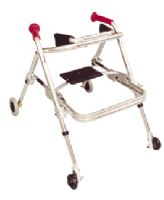 | Kaye PostureRest Posterior Walkers with Seats View Product |
In our number 5 spot, the Kaye PostureRest Posterior Walkers with Seats stand out with their innovative design. They combine mobility support with built-in seating for added convenience and versatility. Unlike traditional walkers, these models allow users to take a break and rest whenever needed, enhancing participation in various activities in diverse settings. Available in multiple sizes and configurations, including 2-wheeled, 4-wheeled, and swivel-wheeled formats, they cater to a wide range of users, from toddlers to adults, and offer silent rear wheels for smooth maneuverability.
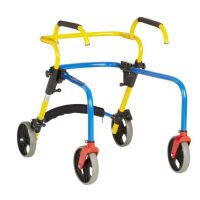 | Pluto Posterior Walker for Children by Rebotec View Product |
The German-engineered Pluto Reverse Child Walker and Gait Trainer by Rebotec secures the 4th spot on our list with its vivid, engaging colors and both height and width adjustability. Offered in a small size for kids up to 132 pounds and a large size for kids and teens up to 176 pounds, this strong, durable, but lightweight aluminum walker from Rebotec is ideal for use as both a walking support and balancing aid and as a therapeutic rehabilitation device for gait training.
Conveniently adjustable in both height and width to grow with your child, its colorful frame delights children and young teens, optimizing compliance for better therapy outcomes.
Cleverly configured with a rear braking system to prevent unintended rollback, the steerable front wheels and fixed rear wheels are also solid and puncture-proof to ensure dependable functionality. For children unable to control the swiveling of the standard steerable wheels, the option of installing front wheels with steer-lock can be selected as an add-on. A comfortable saddle seat can also be added to provide a convenient place for resting when the child tires of walking. Its reverse, posterior configuration ensures upright walking and improved posture.
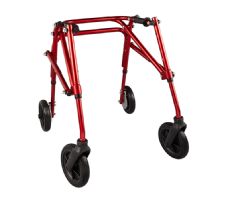 | Klip Gait Trainer Outdoor Walker w/ Big Wheels View Product |
We awarded third place in our review to the Klip Gait Trainer Outdoor Walker w/ Big Wheels by Circle Specialty Inc. for its versatility and multifunctionality, incorporating many of the best design features of the other walkers on our list. Its 4-wheel format uses large, rubber, groove-textured 8-inch wheels to ensure safety and traction on uneven outdoor terrains, while it can also be used indoors. Choose the walker with or without a fold-down seat in a selection of 4 different sizes that are conveniently height-adjustable to grow along with your child. They come in bright, vivid blue and red colors that are attractive to children and teens and accommodate up to 75 pounds for the extra-small size and up to 190 pounds for the large size.
A comprehensive selection of optional support features optimizes user comfort, mobility, and safety, including cushioned sling seats, forearm support platforms, and bumper guards. The Klip’s hand grips are designed with flanged ends to reduce hand strain, while its super lightweight frame, ranging from 12 pounds for the extra-small and 18 pounds for the large, makes the walker easier to control and navigate for children. Simple and quick foldability ensures convenient, compact transport and storage.
Its one-directional rear wheels prevent backward rolling, a safety feature that can be disengaged as the child’s walking skills, gait pattern, and leg strength improve. Its 360-degree swiveling front wheels optimize turning and steering, using a foot-activated wheel lock for easier, improved control. One of the coolest things about the Klip is that it can be used as both a posterior walker and an anterior walker, although this is not available on the extra-small model. This is the perfect pediatric walker for kids learning to transition from an anterior style to a posterior style, as most experts agree that posterior walkers are the better option for children.
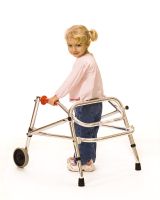 | Kaye Posterior Pediatric Walker for Posture Control View Product |
Ranking at number 2 is the Kaye Posterior Pediatric Walker for Posture Control which offers a multitude of standard beneficial features and add-on customization options to meet the needs of almost any child or teen. Available in 5 sizes to fit toddlers through adults, this walker safely accommodates user weight limits between 60 pounds for the X-small and 210 pounds for the X-large. Conveniently height-adjustable to ensure an ergonomic fit for growing children, this walker from Kaye Products is also quick and easy to fold up for compact transport, travel, and storage.
Offered in a 2-wheeled or 4-wheeled format, this pediatric posterior walker also comes in a 4-wheeled design with swiveling front wheels. Lockable for straight-ahead tracking, the swivel front wheels can be unlocked for easier maneuverability and turning in limited indoor spaces. Swivel limiters can also be added for children who cannot manage the full swivel option but do like the improved turning ability. To enhance safety, the standard 4-wheel walker uses 4 ratcheted wheels that will not roll back, while the swivel front-wheel design has the ratcheted wheels in the back. Helping to improve postural alignment and balance, this walker maximizes walking potential and improves components of gait.
.jpg&newwidth=365&maxheight=200) | Drive Nimbo Posterior Pediatric Walker and Gait Trainer View Product |
The Drive Nimbo Posterior Pediatric Walker and Gait Trainer earns our number 1 spot for its exceptional combination of affordability, durability, and functionality, making it an ideal choice for children in early and middle childhood. With height-adjustable handles and a durable aluminum frame, it provides reliable stability while promoting proper posture and gait. Unlike other walkers, the Nimbo features an override bracket for forward and reverse mobility, enhancing the child's rehabilitative experience and increasing their stride length.
Posterior pediatric walkers provide healthy, upright walking support for children and teens living with temporary or permanent mobility impairments. Often used for kids with cerebral palsy, congenital disorders, neurological or neuromuscular conditions, and developmental delays, posterior walkers are also used to support and re-learn how to walk following an injury, illness, or surgery.
Choosing the best posterior walker is dependent on several factors, including your child’s level of ability, size, and unique support requirements. While all the walkers we chose for our review have specific design attributes that will make any of them the best choice for specific users, we selected the Drive Nimbo Posterior Pediatric Walker and Gait Trainer as our number one choice. Combining many of the best features of the other walkers in our review, the Drive Nimbo is particularly effective at helping children stand upright while also increasing stride length and velocity. Be sure to consult with your child’s doctor to determine the most appropriate and safest walker to meet their needs.
We invite you to check out all of the quality pediatric mobility support devices we offer, along with our helpful and informative caregiving and special needs parenting tips at Caregiver University, a free educational resource!

Co-founder/CEO of Rehabmart, Pediatric Occupational Therapist, husband, and father. Passionate about connecting special needs kids with superb nutrition, sensory integration, and complementary health strategies. Excited about Rehabmart's mission to become the premier online educational platform which empowers caregivers by spotlighting innovative devices and interventions to achieve optimal patient response and recovery.